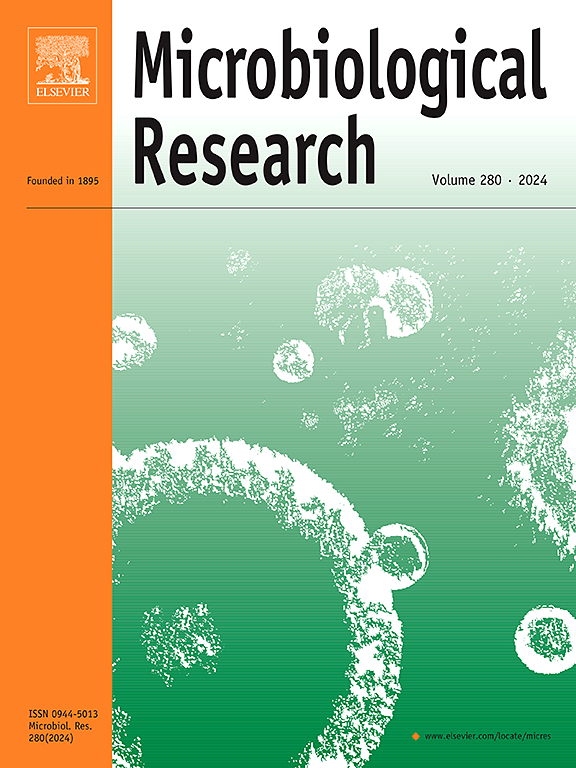水萃取土壤化学物质在调节土壤细菌群相关的N₂O排放中的主导作用
IF 6.1
1区 生物学
Q1 MICROBIOLOGY
引用次数: 0
摘要
土壤氧化亚氮(N₂O)排放受土壤化学性质和微生物组成的影响;然而,他们的相对贡献仍不清楚。我们利用黑土(BS)和潮土(FS)两种对比土壤的土壤-水提取物(SW)和细胞提取物(细菌组)来评估水可提取土壤化学物质和细菌组如何直接影响N₂O排放,以及SW如何影响细菌组组成。结果表明,SW化学,特别是pH,在调节反硝化动力学中起主导作用,而细菌组的作用不太显著。在天然BS水提物(BSW, pH 6.5)中,BS (BB菌群)细胞提取物的N₂O排放量高(N₂O指数= 0.669),但在FS水提物(FSW, pH 8.2)中,BS (BB菌群)细胞提取物的反硝化效率提高,N₂O指数降至0.0491。相反,来自FS (FB细菌组)的细胞提取物在天然FSW (pH 8.2)中表现出有效的反硝化作用(N₂O指数= 0.006),但暴露于BSW会增加N₂O排放量(~ 100µmol /瓶,N₂O指数= 0.295)。细菌群落分析表明,高pH环境中存在多种反硝化菌,包括含napa的Pseudoxanthomonas和Lysobacter,以及与N₂O还原有关的nosZ Clade II Chitinophaga。相反,低pH有利于含钠的不完全反硝化菌,如克雷伯氏菌和肠杆菌。在BB菌群中,BSW促进了Rhodanobacter,阻碍了完全反硝化,而FSW富集了Cupriavidus和Ensifer等完全反硝化菌。相反,BSW对FB菌群中完全反硝化菌Acidovorax的富集产生负向影响。这项研究为土壤理化性质和细菌组成在农业土壤中决定N₂O通量的关键作用提供了越来越多的证据。本文章由计算机程序翻译,如有差异,请以英文原文为准。
Dominant role of water-extractable soil chemicals in modulating N₂O emissions relative to soil bacteriome
Soil nitrous oxide (N₂O) emissions are influenced both by soil chemical properties and microbiome composition; however, their relative contributions remain unclear. We used soil-water extracts (SW), and cell extracts (bacteriomes) from two contrasting soils, black soil (BS) and fluvo-aquic soil (FS), to evaluate how water-extractable soil chemicals and bacteriomes directly impact N₂O emissions, as well as how SW influences bacteriome composition. Results show that SW chemistry, particularly pH, plays a dominant role in regulating denitrification dynamics, while bacteriome effects are less significant. In native BS water extract (BSW, pH 6.5), cell extract from BS (BB bacteriomes) exhibited high N₂O emissions (N₂O index = 0.669), but their denitrification efficiency improved in FS water extract (FSW, pH 8.2), reducing the N₂O index to 0.0491. Conversely, cell extract from FS (FB bacteriomes) in native FSW (pH 8.2) demonstrated efficient denitrification (N₂O index = 0.006), but exposure to BSW increased N₂O emissions (∼ 100 µmol vial⁻¹, N₂O index = 0.295). Bacterial community analysis revealed that high pH fostered diverse denitrifiers, including napA-harboring Pseudoxanthomonas and Lysobacter, and nosZ Clade II Chitinophaga, which are linked to N₂O reduction. In contrast, low pH favored narG-harboring incomplete denitrifiers like Klebsiella and Enterobacter. In the BB bacteriome, BSW promoted Rhodanobacter, which hindered complete denitrification, while FSW enriched complete denitrifiers like Cupriavidus and Ensifer. Conversely, BSW negatively impacted the enrichment of complete denitrifier Acidovorax in the FB bacteriome. This study contributes to the growing evidence of the critical roles of soil physicochemical properties and bacteriome composition in determining N₂O fluxes from agricultural soils.
求助全文
通过发布文献求助,成功后即可免费获取论文全文。
去求助
来源期刊

Microbiological research
生物-微生物学
CiteScore
10.90
自引率
6.00%
发文量
249
审稿时长
29 days
期刊介绍:
Microbiological Research is devoted to publishing reports on prokaryotic and eukaryotic microorganisms such as yeasts, fungi, bacteria, archaea, and protozoa. Research on interactions between pathogenic microorganisms and their environment or hosts are also covered.
 求助内容:
求助内容: 应助结果提醒方式:
应助结果提醒方式:


